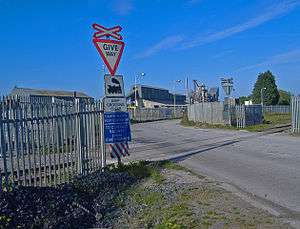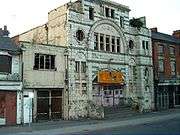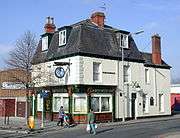Dairycoates
Coordinates: 53°43′51″N 0°22′44″W / 53.730897°N 0.378970°W

Dairycoates is an area of Kingston upon Hull, East Riding of Yorkshire, England, a former Hamlet.
The area was formerly the site of a major North Eastern Railway engine shed, Dairycoates Engine Shed (est.1863, closed 1970). Most of the Dairycoates area is now in industrial use, including the Brighton Street Industrial Estate, located on former rail use land.
Geography
Dairycoates is located roughly halfway between the town centres of Hull and Hessle, at the western edge of the Hessle Road urban area, and its junction with the A1166; Gipsyville is immediately to the west, and contains the Dairycoates Industrial Estate; the two areas are separated by the Hull to Selby railway line which runs to Paragon station and the Hull Docks. Hawthorn Avenue connects northward to the Anlaby Road area of Hull.[1]
Most of the modern area is used for industrial activity, including the Brighton Street Industrial Estate on Freightliner Road. The modern A63 runs through the south of the area; to the south is the St Andrews Quay retail park.[1]
History
Dairycoates Lodge was constructed 1809 by Antony Atkinson, merchant.[2] Only three persons were recorded at Dairycoates in Edward Baines' 1823 Gazeteer: two persons involved in brick and tile manufacturing including Anthony Atkinson, and a farmer.[3] Hawthorn Avenue (then Chalk Lane) was built sometime after 1824.[4] The Hull and Selby Railway was constructed through the area in the 1830s. In 1846 a branch line, the Hull and Bridlington Branch Line was constructed from the Hull and Selby Line at a junction at Dairycoates.[5]
An engine shed was first established c.1863.[6] The shed was expanded during the late 19th and early 20th century into one of the largest on the North Eastern Railway's system. Two square roundhouse sheds were added 1876.[7][8]
In the 1850s the area contained only the railway lines; the hamlet (farm) of Dairy Coates, located within the triangle of land formed by the junctions of the railway lines; a brick and tile works to the east; and further east, the houses Dairy Coates Grange, and Dairy Coates Lodge; the land was in agricultural use, and the only roads the east west Hessle and North Ferriby Tunpike (later "Hessle Road"), and Chalk Lane, running north off it. The area was adjacent to the Humber estuary bank, and the Hull railway ran alongside the bank. Much of the area was within the (detached) parish of North Ferriby.[9]
Sheahan recorded a residence Dairycoates Villa, on the Humber bank within the boundaries of Hull, and beyond it Diarycoates Lodge.[10] Dairycoates Inn was built in 1874.[11] A wagon works, Newington Wagon Works (later Hull Cart, Wagon & Iron Company) was established in 1879, east of the Bridlington railway line and south of Hessle Road.[4]
To the south of the railway line St. Andrew's Dock was opened in 1883 (expanded 1890s), on land reclaimed from the Humber.[12] The Hull and Barnsley Railway opened in 1885, with branch line passing through the area to a freight terminus, Neptune Street goods station.[13] By the 1890s Dairycoates Grange and Lodge had been demolished, replaced by the expansion of the railway lines. By the same period the westwards urban growth of Hull along Hessle Road had reached the area.[14] By the first decade of the 20th century the urban extent of Hull had become continuous westwards as far as Dairycoates, with the Hull-Bridlington branch line co-incident with the western boundary of urban growth. The industrial development and housing later known as Gipsyville, west of Dairycoates had begun by this period.[15] The general pattern of development remained constant through much of the 20th century, whilst Hull grew westwards into Gipsyville and towards Hessle and Anlaby.[16]
A church, St Mary and St Peter was established on Hessle Road in 1902, north of the wagon works; in 1906 it became a chapelry of the parish of Newington (deconsecreated and demolished, 1962).[17][18][note 1] In 1912 the Eureka cinema opened on Hessle Road (closed 1959).[20] (see also Closed cinemas in Kingston upon Hull).

The Dairycoates engine shed was expanded by the addition of a third shed in 1915/16.[7][8] A mechanical coaling plant was also added in the same period.[21] At the 1923 Grouping the overall facility contained 6 roundhouses, and a straight shed, with a capacity of 150 engines.[7][8]
In 1962 the level crossing (Hessle Road (Dairycoates) level crossing) at the eastern edge of the area was replaced with a road flyover (the "Hessle Road flyover" or "Dairycoates flyover") at a cost of over £800,000 to reduce road congestion. Nearly £500,000 was contributed by the government, and nearly £140,000 by the BTC.[22][23][note 2]
The Dairycoates engine shed closed in 1970.[7][8] Tilcon built a rail connected asphalt concrete plant in the 1970s.[27] As of 2013 the plant is operated by Lafarge Tarmac (2013), with the rail connection operated by DB Schenker Rail (UK).[28] Supplied (2009) with stone from Rylstone.[29] The Neptune Street goods branch of the former Hull and Barnsley line also had been closed and removed by the 1970s.[13][30]
By the 1990s the former railway and engine shed land had been redeveloped as an industrial estate.[31] Birds Eye opened a pea processing facility on the estate in 2007.[32][33]
An Lidl supermarket was built in the 2000s[34] over a site including the demolished former Eureka picture palace.
In 2016 Lidl announced it intended to close its supermarket and build a larger one across from the previous site nearer to Brighton Street.[35]
|
See also
- For the nearby Dairycoates Industrial Estate, see Gipsyville.
Notes
- ↑ The church of St Mary and St Peter was demolished due to road improvement; a new church was built on the opposite side of the road. The church closed 1969.[19]
- ↑ By the 1990s the flyover was affected by Concrete degradation due to reinforcement corrosion and was reinforced by the conversion of the voids in the approaches into arches.[24] The main concrete deck span has also required reinforcement,[25] strengthening work was carried out in the late 2000s.[26]
References
- 1 2 Ordnance Survey 1:2500 2006; Bing Maps 2015 www.bing.com/maps
- ↑ Allison, K.J. (1981), Hull Gent seeks country residence, East Yorkshire Local History Society, p. 38
- ↑ Baines, Edward (1823), History, Directory & Gazeteer, of the County of York, 2, p. 192
- 1 2 "Hawthorn Avenue", Anlaby Road History, retrieved 31 August 2015
- ↑ See Hull and Selby Railway, Hull and Bridlington Branch Line.
- ↑ Hoole 1986, p. 52.
- 1 2 3 4 "Steam Locomotive Shed 53A Hull Dairycoates", www.railuk.info, retrieved 31 August 2015
- 1 2 3 4 Hoole 1986, p. 53.
- ↑ Ordnance Survey Sheet 240 1853 1:10560
- ↑ Sheahan, James Joseph (1864). General and concise history and description of the town and port of Kingston-upon-Hull. Simpson, Marshall and Co. (London). p. 624.
- ↑ Pevsner & Neave 1995, p. 550.
- ↑ See St. Andrew's Dock.
- 1 2 See Hull and Barnsley Railway.
- ↑ Ordnance Survey Sheet 240 1893 1:10560
- ↑ Ordnance Survey Sheet 240NW 1906-8 1:10560
- ↑ Ordnance Survey Sheet 240NW 1926, 1938, 1947-9, 1956 1:10560
- ↑ Allison, K.J., ed. (1969), "The parish churches", A History of the County of York East Riding, 1. The City of Kingston Upon Hull, pp. 287–311
- ↑ Ordnance Survey 1910 1:2500
- ↑ Dixon, S.J., Hull Churches and Parishes, retrieved 31 August 2015
- ↑ Allison, K. J., ed. (1969). "26. Social Institutions : Cinemas". A History of the County of York East Riding: Volume 1: The City of Kingston upon Hull. Institute of Historical Research. pp. 418–432.
- ↑ Sources:
- "Mechanical Coal Stage, Dairycoates, Hull", The Railway Gazette, 25: 233, 1916
- "Mechanical Coal Stage at Hull" (PDF), The Engineer, 122, p.331; illus." p.326, 13 October 1916
- ↑ Ordnance Survey. 1:2500; 1950-1, 1969
- ↑ Sources:
- Allison, K.J., ed. (1969), "Communications — Railways", A History of the County of York East Riding, 1: The City of Kingston upon Hull, pp. 387–397
- "Bridge replaces level crossing after 30 years of argument", The Municipal Journal, Public Works Engineer and Contractors' Guide, 69 (3555-3567): 2161, 30 June 1961
- "Hull Level Crossing to Go", The Civil Engineer, 15: 286, 1961
- Journal of the Town Planning Institute, 47-48: 166, 1961 Missing or empty
|title=(help)
- ↑ "Case study- Strengthening a flyover bridge — Hessle Road" (PDF), www.crreynolds.co.uk, 2007
- ↑ "Projects — Hessle Road Flyover", www.masonclark.co.uk
- ↑ Taylor, Andrew (7 May 2013), Briefing Paper to the Environment and Transport Overview and Transport Commission, Hull City Council, 2. Background,
Between 2006 and 2011 higher priority works were carried out to strengthen substandard weak bridges including Church Street Bridge in Sutton, Anlaby Road Flyover and Hessle Road Flyover
- ↑ Goode, C.T. (1981), Railways of East Yorkshire, p. 89
- ↑ Sources:
- FREIGHT SITES CONTROLLED BY FREIGHT TRAIN OPERATORS (FOCs), Network Rail, December 2011
- RAIL SERVED AGGREGATES AND MINERALS HANDLING LOCATIONS (6), October 2013
- ↑ Yorkshire and Humber Route Utilisation Strategy (PDF), Network Rail, July 2009, Construction, p.37
- ↑ Ordnance Survey 1968-9 1:2500
- ↑ Ordnance Survey 1994 1:1000
- ↑ "Birds Eye Pea Processing Plant, Hull, United Kingdom", www.foodprocessing-technology.com, retrieved 16 August 2015
- ↑ "From pod to pack: The journey of a humble Birds Eye pea", Hull Daily Mail, 16 August 2015, retrieved 31 August 2015
- ↑ (04/01086/FULL) 1) Erection of building to provide foodstore with associated car parking and service yard. 2) Erection of two storey building to provide retail premises. (planning application), Hull City Council, 21 June 2004
- ↑ Campbell, James (28 July 2016), "Lidl to build large new supermarket off Hessle Road in Hull", www.hulldailymail.co.uk
Sources
- "History of Dairy Coates, in Kingston upon Hull and East Riding", A Vision of Britain through Time, GB Historical GIS / University of Portsmouth, retrieved 31 August 2015
- Hoole, Ken (1986) [1965], "The North East", A regional history of the railways of Great Britain (3 ed.), David and Charles, 4
- Pevsner, Nikolaus; Neave, David (1995), "Yorkshire: York And the East Riding", Pevsner Architectural Guides (2nd ed.), Yale University Press, ISBN 0 300 09593 7
External links
| Wikimedia Commons has media related to Dairycoates, Kingston upon Hull. |

